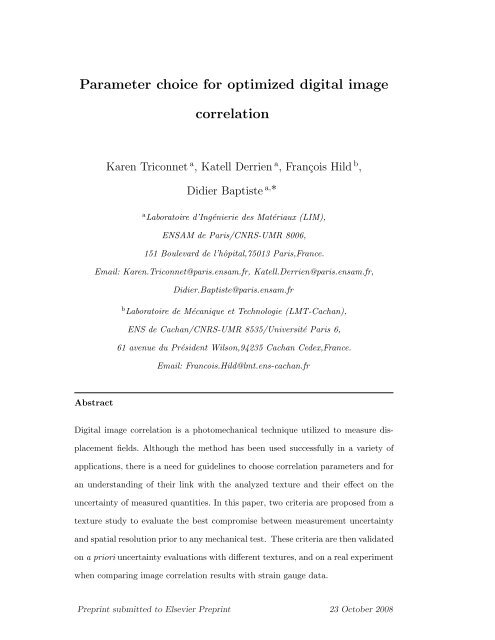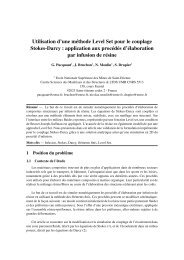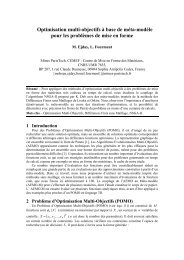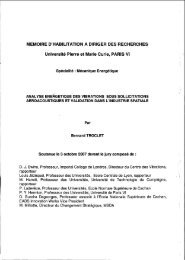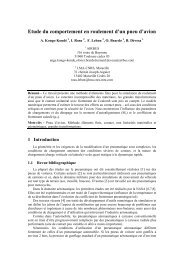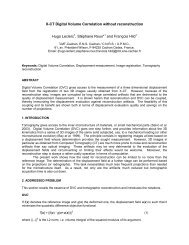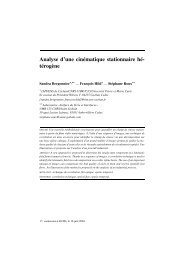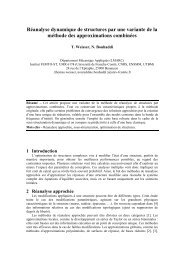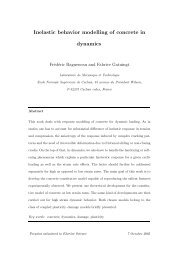Draft PDF - ENS Cachan
Draft PDF - ENS Cachan
Draft PDF - ENS Cachan
Create successful ePaper yourself
Turn your PDF publications into a flip-book with our unique Google optimized e-Paper software.
Parameter choice for optimized digital imagecorrelationKaren Triconnet a , Katell Derrien a , François Hild b ,Didier Baptiste a,∗a Laboratoire d’Ingénierie des Matériaux (LIM),<strong>ENS</strong>AM de Paris/CNRS-UMR 8006,151 Boulevard de l’hôpital,75013 Paris,France.Email: Karen.Triconnet@paris.ensam.fr, Katell.Derrien@paris.ensam.fr,Didier.Baptiste@paris.ensam.frb Laboratoire de Mécanique et Technologie (LMT-<strong>Cachan</strong>),<strong>ENS</strong> de <strong>Cachan</strong>/CNRS-UMR 8535/Université Paris 6,61 avenue du Président Wilson,94235 <strong>Cachan</strong> Cedex,France.Email: Francois.Hild@lmt.ens-cachan.frAbstractDigital image correlation is a photomechanical technique utilized to measure displacementfields. Although the method has been used successfully in a variety ofapplications, there is a need for guidelines to choose correlation parameters and foran understanding of their link with the analyzed texture and their effect on theuncertainty of measured quantities. In this paper, two criteria are proposed from atexture study to evaluate the best compromise between measurement uncertaintyand spatial resolution prior to any mechanical test. These criteria are then validatedon a priori uncertainty evaluations with different textures, and on a real experimentwhen comparing image correlation results with strain gauge data.Preprint submitted to Elsevier Preprint 23 October 2008
Key words: digital image correlation, texture, optimization1 IntroductionThe measurement of 2D or 3D surface motions in an image sequence can beperformed by pattern matching of various “markers” [1]. An image is representedby a gray level matrix. During a mechanical test, the intensity mapis advected by a displacement field to be determined. The measurement ofthe displacement is an ill-posed problem [2] since it can only be determinedalong the direction of the intensity gradient. This shows that the property ofthe underlying texture influences the performance of the measurement technique.One of the most popular matching procedure aims at maximizing thecross-correlation function [3,4] by seeking, for example, piece-wise constantdisplacements in interrogation windows.Two types of situations arise in practice. First, the natural texture is sufficientto use a correlation algorithm. For example, the deformation of mineralwool samples can be analyzed with no special preparation [5]. Similarly, theroughness of a ceramic sample can be sufficient to study displacement fieldsin a notched beam [6]. Alternatively, artificial markers can be deposited onthe surface of interest to create a random texture, e.g.,a black and white layercan be sprayed [7]. In both situations, there is a need for the characterizationthe “quality” of the texture when correlation techniques are to be used andone wants to assess the displacement and/or strain uncertainties.To evaluate the performance of a correlation algorithm, purely artificial pat-∗ Corresponding author. Tel: +33 1 40 44 20 16.2
terns can be simulated. For instance, Sutton et al. [8] use a decreasing exponentialfunction as a model for the intensity pattern. The generation of black dotson a white background can also be described by using a Poisson-point processand the picture is the result of the union of all the generated dots [9]. Characteristicproperties of this type of texture are easy to derive in terms of averageintensity and two-point correlation properties [9,10]. For speckles, statisticalmodels have also been proposed to characterize the pattern observed from thediffraction phenomenon [11–15]. The advantage of these texture models is thatthey can be used to evaluate precisely the performance of a correlation algorithmsince the displacement can be applied to each pattern with numericalaccuracy. However, the previous models are idealizations of practical texturesthat can take very different patterns.When performing experiments, the random texture has not always the desiredfeatures and the user may wonder whether the correlation technique willyield robust results. An a priori analysis of the texture is desirable before performingthe actual experiment. Under these circumstances, a texture analysisis helpful and artificial motions can only be applied artificially by gray levelinterpolation (e.g., linear, spline[8]) or by Fourier transform by using theshift-modulation property[16]. An alternative route consists in acquiring aset of pictures of the same surface and computing the corresponding uncertainties.This procedure characterizes the resolution of the technique [17] anddoes not necessarily yield the largest sub-pixel uncertainty levels as will beshown.In this paper, three different ways of analyzing a texture are proposed when acorrelation technique is used to determine 2D displacement fields. The presentgoal is to estimate the sub-pixel displacement errors of a correlation code, and3
the effect on strain uncertainties. Section 2 recalls the basics of the digitalimage correlation algorithm used herein, and introduces the method used toanalyze the texture. Then, two criteria are established (Section 3), testedon thirty one different textures and validated on an experimental applicationwith strain gauge measurements to compare results (Section 4). An alternativeapproach is proposed leaving more freedom to the user, which is also more timeconsuming.2 Displacement measurement by image correlation: The role of thetextureTo determine a displacement field, one uses two pictures (one correspondingto the reference state, and the other one of the deformed state of a surface).One considers a set of windows in the reference picture (i.e., a square regionof N × N pixels) that will be referred to as Zone Of Interest (ZOI), and theircorresponding positions are sought in the “deformed” picture. In the following,it is assumed that the separation between neighboring ZOI centers is constantand equal to ∆P (this parameter characterizes the “measurement mesh”).2.1 Correlation procedureThe displacement of a ZOI in the deformed picture with respect to that inthe reference picture is a two-dimensional shift of an intensity signal digitizedby, say, a CCD or CMOS camera. To estimate a shift between two signals,one of the standard approach utilizes a correlation function. One considerssignals g(x) that are merely perturbations of a shifted copy f(x − u) of some4
eference signal f(x)g(x) = f(x − u) + b(x) (1)where u is an unknown displacement (here assumed to be uniform over theZOI) and b(x) a random noise. To evaluate u, one minimizes the norm of thedifference between f(x − U) and g(x) with respect to a trial displacement UUmin‖g − f(. − U)‖ 2 (2)If one chooses the usual quadratic norm ‖f‖ 2 = ∫ f 2 (x)dx, the previous minimizationproblem is equivalent to maximizing the quantity h(U)∫h(U) = (g ⋆ f)(U) =g(x)f(x − U)dx (3)where ⋆ denotes the cross-correlation product. Furthermore, when b is a whitenoise, the previous estimate is optimal. The computation of a cross-correlationis performed either in the original space, or in Fourier space, by using a fastFourier transform (FFT)g ⋆ f = NFFT −1 (FFT[g] · FFT[f]) (4)where the complex conjugate is overlined, and N 2 is the number of samplesin the Fourier transform (to use “fast” algorithms [18], it is required thatN = 2 npixels, where n is an integer). This condition may be relaxed byusing zero-padding or neutral padding techniques [19]. In the sequel, it will beassumed that the ZOI size l is characterized by the integer l = 2 n .5
2.2 Ultimate performanceLet us evaluate the sensitivity vector of a correlation technique. As a firstapproximation, small displacements U are sought, and one can consider afirst order Taylor expansion of g in Equation (1) with respect to Ug(x) ≈ f(x) − U.∇f(x) (5)which shows that the sensitivity vector of digital correlation is ∇f and thatthe displacement evaluation is a priori an ill-posed problem since only displacementsalong the gradient vector can be detected. It is partially solvedby a regularization over small zones, e.g.,the ZOIs defined earlier, themselvesdefining the spatial resolution for a displacement measurement (i.e., the minimumdistance to have independent measurements). Furthermore, contrary toother optical techniques such as moiré interferometry, the sensitivity variesfrom zone to zone since it is directly related to the texture of the region ofinterest. This result explains why a texture analysis is useful to evaluate actualperformances of a digital image correlation software. The sensitivity S(n)associated to each displacement direction n is given byS(n) = 1n.∇f(6)and its maximum value is denoted by S max . Equation (5) also shows that thesmallest measurable displacement is obtained for the smallest picture difference(i.e., one gray level) and the highest sensitivity. It scales asU min ∝ S max (7)6
where S max is the inverse of the maximum picture gradient. This value has tobe corrected for to account for noise associated to the image formation andacquisition process as well as the fact that the CCD sensor does not cover thewhole pixel surface. It is expected that the actual estimate is greater than thetheoretical value. In practice, 1/S max is only a fraction of the dynamic rangeand not all ZOIs achieve this value. Consequently, the practical discriminationthreshold is a quantity that strongly depends on the texture, in particularits standard deviation. By considering a uniform distribution of gray levelsranging from 0 to G max , the maximum gradient is related to the standarddeviation σ byS max = 1G max= 1 √12σ(8)so that, for the sake of simplicity, the standard deviation of the gray leveldistribution will be considered in the texture analysis.To evaluate sub-pixel displacements, the cross-correlation function is interpolated.For instance, bi-parabolic interpolation can be used and a one hundredthpixel standard uncertainty [17] is achieved [8,16] for 8-bit pictures. To be consistentwith the present approach, the interpolation and correlation productwill be considered in the next section to introduce texture criteria to determinethe performance in terms of displacements (and strains) measured byimage correlation.3 Texture analysisIn practice, a very large variety of pictures is handled when using image correlationtechniques. The image “quality” is one key parameter for evaluating7
the performances of a digital image correlation (DIC) technique. Yet, otherexperimental parameters influence the quality of a picture such as:• performances of CCD or CMOS sensors (e.g., digitization, read-out noise,black current noise, photon noise [20]);• position and intensity of the light source with respect to the specimen andthe camera.The image digitization still uses mostly 8-bit encoding sensors. However, CCDcameras digitizing with 10, 12 or even 16 bits are now available. When usingan 8-bit CCD camera, a pixel can take any value of the 2 8 dynamic range.Under a uniform distribution hypothesis, a lower bound to the discriminationthreshold u min is given by (see Equation (7))U min = 1∆N g= 1σ √ 12(9)where ∆N gis the signal range, here equal to the dynamic range 2 8 and σthe standard deviation associated with a uniform distribution. For an 8-bitdigitization, a correlation algorithm will not detect displacements less than2 −8 pixel. An estimate of the discrimination threshold for strains ɛ min consistsin considering the minimum displacement variation equal to the discriminationthreshold over a gauge length equal to 2∆Pɛ min = U min2∆P(10)since a displacement gradient is usually computed by either using a centereddifference scheme or enhanced algorithms [21,22], some of them also using aneighborhood of 8 points in addition to the considered one. For a separationof 32 pixels, and an 8-bit digitization, a lower bound to the discrimination8
threshold is of the order of 6 × 10 −5 . These ultimate performances may be farfrom actual performances due to the quality of the texture. There is thereforea need for criteria to help the user choose the best possible correlationparameters, namely, the ZOI characterized by n, and ∆P .To obtain the maximum number of independent displacement measurements,the user wants to determine the lowest possible ZOI size (i.e., the spatial resolutionof a DIC technique when displacements are sought) associated to theexperiment that is performed. For a displacement measurement, as illustratedin Figure 1 by any open circle, the spatial resolution corresponds to the ZOIsize, and independently of the separation ∆P . On the left-part of Figure 1, theseparation is equal to the ZOI size whereas on the right-part the separationrepresents half the size of the ZOI. By applying an enhanced algorithm [22],Figure 1 shows that the data used for a strain measurement (i.e., solid circles)are located in the dashed square area. The corresponding spatial resolution associatedto strain measurements is defined 1 as l 2 + (2∆P ) 2 pixels. Figure√1illustrates two different cases where the spatial resolution for displacementmeasurement is equal to l but on the left-part the strain spatial resolutionis equal to √ 5l and on the right-part to √ 2l due to the choice of differentseparations. However, in the last case, the displacement measurements are notindependent.1 the evaluation of a strain can be considered as the successive application of twowindows, the first one of size l to determine the displacement data, and a secondone of size 2∆P in the present case for the derivation stage9
3.1 A priori criteriaIn the following, the separation ∆P will be equal to the ZOI size l in orderto use only independent measurement data. It is proposed to characterize apattern by three different quantities. Associated to some of these parameters,criteria are to be defined to guarantee a priori correlation results. Thefollowing choice is made:• A global information on the gray level distribution of a picture is givenby its histogram. This information is usually checked by the user to avoidlow/high level saturation and to use most of the dynamic range of the camera.Figure 2 shows an example of a gray level distribution for an artificialtexture. Its histogram corresponds to a non-uniform distribution of graylevels. No significant saturation is observed and most of the dynamic rangeof the 8-bit camera is used.• The previous representation is global (i.e., associated with the whole picture).A more local quantity relevant to each ZOI is the standard deviationσ ZOI of its gray level distribution f ZOI . As noted before, a correlation algorithmdoes not work with a uniform gray level distribution. Consequently,a first criterion is related to a minimum value σ min of σ ZOI , or similarly toa discrimination threshold (see Equation (9)).• The autocorrelation function of each analyzed ZOI of the picture characterizesits two-point distribution. A representative “speckle” size (i.e., correlationradius) for each ZOI is sought. In a discrete setting, the autocorrelationfunction is defined asA ZOI (I, J) = f ZOI ⋆ f ZOI (I, J) =∑2 n ∑2 ni=1 j=1˜f ZOI (i, j) ˜f ZOI (i + I, j + J) (11)10
where ˜f is the periodic representation of the gray level distribution f of eachZOI. Figure 3 shows the autocorrelation function of a given 32-pixel ZOI.The DC component of the ZOI has been removed, and the autocorrelationfunction has been normalized by its maximum value reached when I = 0and J = 0. The (normalized) autocorrelation function ÂZOI is interpolatedas ZOI (x, y) ≈ 1 − (ax 2 + 2bxy + cy 2 ) (12)where a, b, c are identified by considering the 8 nearest points to the origin,x and y are the continuous coordinates around the maximum point locatedat the origin. Two correlation radii R 1 and R 2 are corresponding to theprincipal axes of the ellipse defined as the intersection of the interpolatedautocorrelation function with the zero height plane⎧⎪⎨⎪⎩R −21 = a+c2+R −22 = a+c2−√ ( ) 2 a−c2 + b2√ ( ) 2 a−c2 + b2(13)The ratio between the two principal radii is a measure of the texture anisotropy [19]and the half-sum R is used to evaluate an average correlation radius of anyconsidered ZOI. A second criterion is related to the comparison of the correlationradius R and the ZOI size. A value ρ = R/l corresponds to a fractionof the ZOI size and a maximum value ρ max is introduced.The limit values of the last two criteria (i.e., σ min and ρ max ) are determinedin the following analysis.11
3.2 Choice and validation of critical valuesAs discussed in Section 2, digital image correlation cannot be used with ahomogeneous distribution of gray levels. Let us still consider a uniform graylevel distribution, i.e., all gray levels have the same probability to be presentin the ZOI, the standard deviation in this case is equal toσ ZOI = ∆N ZOI√ (14)12where ∆N ZOI denotes the dynamic range of a ZOI. In many applications, a0.05-pixel discrimination threshold is acceptable. Consequently, for each ZOIof the studied picture, the gray level standard deviation must be greater than6 gray levels (see Equation (9))σ min = 6 gray levels (15)For more severe applications, this value has to be increased, and also whengreater than 8-bit dynamic ranges are used.To apply digital image correlation to a given window, it is preferable thatat least one speckle (i.e., a black or white dot) and its neighborhood (i.e., awhite or black zone) belong to any ZOI. Consequently, for each ZOI, the ratiobetween the correlation radius related to the ZOI size must not be greaterthan 0.25ρ max = 0.25 (16)The following points can be underlined. First, this type of approach allowsone to choose a ZOI size that is the most fundamental parameter of a DIC12
technique. Each new picture is analyzed independently of previous results. If anatural texture is considered, the user then knows whether it is acceptable interms of “quality” for a DIC algorithm. Conversely, when an artificial patternis created, the user has a way of characterizing its overall properties. If theresult is not satisfactory, the pattern may be recreated again. Second, it is ana priori analysis. Third, there is a need to relate the critical values associatedwith the texture to the performance of a DIC code in terms of displacementand strain uncertainties associated to a spatial resolution.3.3 Performance evaluation and texture analysisThe aim of this study is to evaluate the standard displacement and strain uncertainties,i.e., “the parameter that characterizes the dispersion of the quantityvalues that are being attributed to a measurand, based on the informationused. The parameter may be, for example, a standard deviation called standardmeasurement uncertainty” [17]. In practice, the discrimination threshold is lessthan the standard displacement uncertainty, thus the latter will be assessed.Furthermore, the actual value of the prescribed displacement is not alwayseasy to evaluate. However, fluctuations can be measured and therefore thestandard measurement uncertainty is one key quantity to assess the overallperformance associated to a given picture.3.3.1 Description of a test caseThe texture analysis is related to a picture taken from a tensile test on a singlefiber with an aluminum coating itself embedded in an epoxy resin [23]. A 50-mm lens allows one to monitor a 13 × 9 mm surface (Figure 4) where a black13
and white artificial texture was created. The picture was taken by an 8-bitCCD camera whose resolution is 768 × 576 pixels. The correlation parametersare chosen by following the previous a priori texture analysis. Four differentsteps are performed as illustrated in Figure4:• a rigid body motion is artificially applied to this picture. Ten images arecreated with displacement increments of 0.1 pixel. Two different algorithmsare used. The first one is a pixel by pixel interpolation algorithm thatlinearly interpolates the gray level. The second one uses FFTs and theshift/modulation property. No significant differences between the two methodsare observed;• the eleven-image sequence is analyzed with a DIC software to evaluate thedisplacements for each image (here CORRELI LMT [5]);• Once all pictures have been analyzed, the mean displacement error and thecorresponding standard uncertainty are determined (Figure 5). The standarddisplacement uncertainty is evaluated as the mean of the standarduncertainties for the analyzed sequence. For a given ZOI size, the maximumuncertainty is reached when the prescribed displacement is equal to0.5 pixel. In this case, the information between each ZOI in the referenceand deformed pictures is the most biased.It is worth noting that if successivepictures of the undeformed state are taken, it is virtually impossibleto evaluate the maximum correlation errors since they are not achieved forvery small displacements but for 0.5 pixel;• For strains, the same eleven pictures are used. It is expected that no strainsshould be observed since only rigid body motions are prescribed. The sameprocedure as for displacements is performed and the mean error and thestandard strain uncertainty are calculated from strain fields as shown inFigure 5. By using this procedure, the derivation algorithm to get the strain14
field is tested too, here the one proposed by Geers et al. [22]. The use ofanother derivation scheme and another spatial resolution would change thestrain performance. In terms of uncertainty, the same overall tendency asfor displacements is observed. In particular the maximum value is reachedwhen the prescribed displacement is equal to 0.5 pixel. These results suggestthat a fast uncertainty evaluation only needs one uncertainty estimate fora 0.5-pixel displacement and the corresponding average is approximatelyequal to half of the latter.It has to be noted that even if this procedure uses real pictures, all “experimental”noise that exists during an experiment is avoided (e.g.,lighting, vibrations,texture variations due to strain). If this uncertainty study is applied for differentZOI sizes, it is possible to compare the different performances. In thepresent case, the texture analysis (Figure4) of the picture shown in Figure 2indicates that a 64-pixel ZOI is the appropriate interrogation window size forthe DIC procedure used herein. According to the uncertainty study, for allZOI sizes reported in Figure 6, the standard displacement uncertainty for theoptimized parameter is about of 3.6 × 10 −3 pixel and the standard strain uncertaintyis of the order of 5 × 10 −5 . Performance comparisons can be madebetween different ZOI sizes and, in this case, the optimized parameter givestwo times better results than with a 32-pixel ZOI size.Last, when studying the uncertainties versus the ZOI size, one shows that thereexists a trade off between displacement (and strain) uncertainties and theirassociated spatial resolution. Figure 6-b shows the displacement uncertaintyfor different ZOI sizes. If the ZOI size increases, the spatial resolution is degraded,i.e., fewer independent measurement points are obtained. This trendcan be described by a power law fit relating the displacement uncertainty σ U15
to the ZOI size lσ U = Aα+1l α (17)where A is a constant equal to 1.1 pixels in the present case (see Figure 6-b)and α = 1.3 the corresponding power. The same trend is observed for strains.In the present case, the separation ∆P is equal to the ZOI size l = 2 n pixels.Figure 6-d shows the change in the mean strain uncertainties with the ZOI sizewhen the displacement range varies between 0 and 1 pixel. A power law withan exponent β of the order of 2.2 is obtained for the mean strain uncertaintyσ ɛ as a function of lσ ɛ = Bβ2l β (18)with B = 0.9 pixel. This last result shows that the two uncertainties can berelated by (see Equation (10) for a similar result in terms of discriminationthreshold)σ ɛ = C σ U2∆P(19)since α + 1 ≈ β. In the present case, the constant C is of the order of 0.6(i.e., CA α+1 ≈ B β ).3.3.2 Statistical studyThe previous analysis is performed on a set of images obtained when analyzinga mechanical test. A statistical study is carried out by using 31 different8-bit textures. Among these 31 images, 27 are artificial textures observedwith classical lenses, one is a natural texture observed with classical lens, one16
is an artificial texture observed with a far-field microscope, two are naturaltextures observed with a far-field microscope. The correlation parameters aredetermined by using the critical values chosen before. Standard strain and displacementuncertainties are evaluated and a histogram is plotted in Figure 7.¿From the standard displacement uncertainty histogram, it is concluded thatthe mean value is about 1.2×10 −2 pixel and the associated standard deviationis about 4.9 × 10 −3 pixel. In the present case, a Gaussian fit is reasonable asshown in a normal probability plot in Figure 7. From the standard strainuncertainty histogram, the mean value is ca. 2.6 × 10 −4 and the associatedstandard deviation is about 1.6 × 10 −4 . Again, a Gaussian description seemsreasonable. Among the four last textures, one gives better results than theaverage, two slightly worse and the last one exactly the average value. Evenif these four images represent only 13% of the population, their results arenot different from the overall population. Consequently, the type of texture(i.e., artificial or natural) and observation scale (i.e., classical lens vs. far-fieldmicroscope) are second order parameters compared with the property of thetextures studied herein.When using the texture criteria proposed herein, three cases occur, either thegray level standard deviation (i.e., two cases among the 31 studied) is thelimiting factor, or the correlation radius ratio (i.e., 17 out of 31) is the onlylimitation, or both of them are limits (i.e., 12 out of 31). Table 1 shows a comparisonbetween standard uncertainties and mean errors for each group quotedabove and relates them to average values. Concerning the performance of eachof the three groups compared to the average for both strain and displacementstandard uncertainties, the first one has a better performance, the second onea slightly better one too, and the third one a slightly worse performance. The17
choice of the ZOI size given by the texture analysis yields sufficiently good resultsfor most applications. It can be considered that by using this procedurethe average performances described above can be reached.4 Tensile test on an aluminum alloy with strain gaugesIn this section, the critical values are tested when analyzing a tensile test performedon a 2024 aluminum alloy specimen. Strains deduced from displacementmeasurements are compared with strain gauge data. A special setup isused to avoid spurious flexure [24]. A far-field microscope monitors a 4 mm 2surface (Figure 3). The measurements obtained by digital image correlationare shown to be sufficient to determine the elastic properties of the alloy witha conventional analysis or with the so-called constitutive equation error technique[25].¿From the reference image, a texture study is performed to choose the ZOIsize with the proposed texture criteria. The results are shown in Figure 8.The gray level histogram shows a good distribution without any saturation.A large part of the gray level range is used. The gray level standard deviationcriterion validates the 32-pixel size but the correlation radius requires the ZOIsize to be augmented to 64 pixels. As for the a priori uncertainty study, theseparation ∆P is equal to the ZOI size so that each measurement “point”is completely independent of the other ones. Strains are again computed byusing the procedure proposed by Geers et al. [22].Let us compare the gauges and the digital image correlation results when theZOI size recommended by the texture analysis (i.e., 64 pixels) is used. In thepresent case, the region of interest for the correlation calculation is identical18
to the gauge size so that a direct comparison can be made. The mean strainerror, representing the difference between digital image correlation results fora 64-pixel ZOI size and the gauge data (longitudinal and transverse strains),is less than 5 × 10 −5 . In Figure 10, different ZOI sizes are tested and thecorresponding mean strain errors are evaluated when all the 21 load levels areconsidered. Except for ZOI size of 8 pixels, mean strain errors are less than10 −4 .The results in terms of experimentally observed standard strain uncertainty(i.e., 3.4 × 10 −4 , see Table 2) may appear disappointing in comparison withthe average value obtained with the previous texture analyses (i.e., 2.6 ×10 −4 Table 1) since a 30% difference is found. However, the correct order ofmagnitude is found and this is directly related to the fact that the presentprocedure does not account for all experimental uncertainties (e.g.,associatedwith the image acquisition process on top of the correlation algorithm itself).Even if the actual performances are (slightly) underestimated, the textureanalysis is a simple tool to evaluate a priori and very quickly the textureproperties.One question remains, is the a priori numerical analysis an adapted tool forevaluating the performance of a correlation algorithm prior to performing anexperiment? Figure 10 shows the answer. The experimentally determined anda priori evaluated standard strain uncertainties for each ZOI size in both longitudinaland transverse directions are compared. In a log-log plot, a verygood power law fit is obtained with an exponent of −1.5 for any strain underscrutiny. There is only a multiplicative offset by a factor of the order of1.3. It is therefore concluded that the a priori uncertainty study is validatedand is therefore an appropriate way of evaluating the overall performance of19
a DIC algorithm. Furthermore, the a priori uncertainty study is particularlyadapted to help the user choose the correlation parameters. For this procedure,which only needs one single (reference) image shifted by an amount of0.5 pixel, the user evaluates the displacement and strain errors and standarduncertainties. The texture analysis, which is faster, allows one to choose correlationparameters associated to average performances. It is likely to be easierto use for unexperienced users. More experienced users will want to know moreprecisely, in each particular case, the standard measurement uncertainties.5 ConclusionA texture analysis has been developed and tested in this paper to choose correlationparameters of a DIC code. Two criteria are proposed and are relatedto the standard deviation of the gray level distribution in each interrogationwindow, and a representative “speckle” size (i.e., correlation radius). Whencritical parameters are chosen (e.g.,a minimum standard deviation of 6 graylevels, and a maximum correlation radius equal to one quarter of the ZOIsize), an average value of standard displacement uncertainty of 1.2 × 10 −2pixel is obtained for 31 different textures. The corresponding average value ofthe standard strain uncertainty is equal to 1.6 × 10 −4 .If the user wants a more accurate estimate of the performances, a displacementis artificially prescribed to a picture. Steps of 0.1 pixel are applied from 0 to 1pixel. The standard displacement and strain uncertainties are calculated. Theoverall performance is then given by the mean value of the two uncertaintyfunctions. It can be noted that with the present correlation algorithm, themean uncertainties are equal to one half of the maximum value corresponding20
to a 0.5-pixel displacement. This result is obtained systematically so that apractical way only consists in considering only one displacement level (i.e., 0.5pixel) to get the sought result. With this simplified approach, the computationtime is reduced by one order of magnitude.The texture analysis has been tested when analyzing a tensile test on analuminum alloy where digital image correlation results have been comparedto strain gauge measurements. With the two above criteria, the proposedchoice of correlation parameters gives good results and validates the presentapproach. Furthermore, the present analysis also shows that the a priori estimatesof standard strain uncertainties are in good agreement with valuesobtained in the analyzed experiment when considering the strain gauge resultsas reference data. It is therefore recommended to use this last approachthat quantifies a priori the performance of a correlation algorithm for differentcorrelation parameters, for example the ones obtained from the textureanalysis.AcknowledgmentsThis work was carried out as a collaboration within the CNRS research network“Mesure de champs et identification en mécanique des solides.”References[1] M.A. Sutton, S.R. McNeill, J.D. Helm and Y.J. Chao, “Advances in Two-Dimensional and Three-Dimensional Computer Vision,” in Photomechanics,P.K. Rastogi, eds., (Springer, Berlin (Germany), 2000), pp. 323-372.21
[2] B. Wagne, S. Roux and F. Hild, “Spectral Approach to Displacement EvaluationFrom Image Analysis,” Eur. Phys. J. AP 17, pp. 247-252 (2002).[3] P.J. Burt, C. Yen and X. Xu, “Local correlation measures for motion analysis:a comparative study,” in Proc. IEEE Conf. on Pattern Recognition and ImageProcessing (1982), pp. 269-274.[4] M.A. Sutton, W.J. Wolters, W.H. Peters, W.F. Ranson and S.R. McNeill,“Determination of Displacements Using an Improved Digital CorrelationMethod,” Im. Vis. Comp. 1, pp. 133-139 (1983).[5] F. Hild, B. Raka, M. Baudequin, S. Roux and F. Cantelaube, “Multi-ScaleDisplacement Field Measurements of Compressed Mineral Wool Samples byDigital Image Correlation,” Appl. Optics IP 41, pp. 6815-6828 (2002).[6] P. Forquin, L. Rota, Y. Charles and F. Hild, “A Method to Determine theToughness Scatter of Brittle Materials,” Int. J. Fract. 125, pp. 171-187 (2004).[7] D.S. Dawicke and M.S. Sutton, “CTOA and Crack-Tunneling Measurements inThin Sheet 2024-T3 Aluminum Alloy,” Exp. Mech. 34, pp. 357-368 (1994).[8] M.A. Sutton, S.R. McNeill, J. Jang and M. Babai, “Effects of subpixel imagerestoration on digital correlation error estimates,” Opt. Eng. 27, pp. 870-877(1988).[9] F. Hild, J.-N. Périé and M. Coret, Mesure de champs de déplacements 2D parintercorrélation d’images : CORRELI 2D , report 230, LMT-<strong>Cachan</strong>, (1999).[10] D. Jeulin and P. Laurenge, “Simulation of Rough Surfaces by MorphologicalRandom Functions,” J. Electr. Imaging 6, pp. 16-30 (1997).[11] L.I. Goldfischer, “Autocorrelation function and power spectral density of laserproducedspecke patterns,” J. Opt. Soc. Am. A 55, pp. 247-253 (1965).[12] S. Lowenthal and H. Arsenault, “Image formation for coherent diffuse objects:statistical properties,” J. Opt. Soc. Am. 60, pp. 1478-1483 (1970).22
[13] T.L. Alexander, J.E. Harvey and A.R. Weeks, “Average speckle size as afunction of intensity threshold level: comparison of experimental measurementswith theory,” Appl. Optics 33, pp. 8240-8250 (1994).[14] L. Leushacke and M. Kirchner, “Three-dimensional correlation coefficient ofspeckle intensity for rectangular and circular apertures,” J. Opt. Soc. Am. 11,pp. 671-673 (1994).[15] P. Jacquot, “Figures de speckle : rôle en mécanique expérimentale,” inIdentification du comportement des matériaux et de la rupture des structuresà l’aide de méthodes optiques, IPSI report, Paris, 2003.[16] J.N. Périé, S. Calloch, C. Cluzel and F. Hild, “Analysis of a Multiaxial Test ona C/C Composite by Using Digital Image Correlation and a Damage Model,”Exp. Mech. 42, pp. 318-328 (2002).[17] ISO, International Vocabulary of Basic and General Terms in Metrology (VIM),(International Organization for Standardization, Geneva (Switzerland), 1993).[18] J.W. Cooley and J.W. Tuckey, “An Algorithm for the Machine Calculation ofComplex Fourier Series,” Math. Comp. 19, pp. 297-301 (1965).[19] S. Bergonnier, F. Hild and S. Roux, Local anisotropy analysis for non-smoothimages, Patt. Recogn. 40 [2] (2007) 544-556.[20] G. Holst, CCD Arrays, Cameras and Displays, (SPIE Engineering Press,Washington DC (USA), 1998).[21] L. Allais, M. Bornert, T. Bretheau and D. Caldemaison, Experimentalcharacterization of the local strain field in a heterogeneous elastoplasticmaterial, Acta Met. Mat. 42, pp. 3865-3880 (1994).[22] M.G.D. Geers, R. De Borst and W.A.M. Brekelmans, “Computing Strain Fieldsfrom Discrete Displacement Fields in 2D-Solids,” Int. J. Solids Struct. 33,pp. 4293-4307 (1996).23
[23] K. Triconnet, K. Derrien, D. Baptiste, Y. Surrel and J. Molimard, “Local FieldsMeasurements: Interferometric Moiré and Digital Image Correlation,” in Proc.Society of Experimental Mechanics Conf. X, (SEM, CD-ROM, 2004), 9 p.[24] F. Hild, E. Amar and D. Marquis, “Stress Heterogeneity Effect on the Strengthof Silicon Nitride,” J. Am. Ceram. Soc. 75, pp. 700-702 (1992).[25] G. Geymonat, F. Hild and S. Pagano, “Identification of elastic parameters bydisplacement field measurement,” C. R. Mécanique 330, pp. 403-408 (2002).24
List of Tables1 Mean values • and standard deviations • of the standarddisplacement σ u and strain σ ɛ uncertainties related to thecriterion(a) that is(are) satisfied to choose the correlationparameters for the 31 analyzed pictures. 262 Standard strain uncertainties σ ɛ for 3 different ZOI sizesdetermined with the a priori analysis (APA) and comparedwith actual values (Exp.) for the analyzed experiment. Whenusing the two texture criteria, the first ZOI size to satisfy themboth is 64 pixels. 2725
Table 1Mean values • and standard deviations • of the standard displacement σ u andstrain σ ɛ uncertainties related to the criterion(a) that is(are) satisfied to choose thecorrelation parameters for the 31 analyzed pictures.Criteria Nb. of σ u σ u σ ɛ σ ɛcases (pixel) (pixel)σ ZOI 2 7.6 × 10 −3 5.5 × 10 −3 1.0 × 10 −4 7.6 × 10 −5ρ 17 1.0 × 10 −2 4.3 × 10 −3 2.4 × 10 −4 1.4 × 10 −4σ ZOI & ρ 12 1.5 × 10 −2 4.4 × 10 −3 3.3 × 10 −4 1.8 × 10 −4Mean value - 1.2 × 10 −2 4.9 × 10 −3 2.6 × 10 −4 1.6 × 10 −426
Table 2Standard strain uncertainties σ ɛ for 3 different ZOI sizes determined with thea priori analysis (APA) and compared with actual values (Exp.) for the analyzedexperiment. When using the two texture criteria, the first ZOI size to satisfy themboth is 64 pixels.l (pixels) APA Exp.32 5.9 × 10 −4 9.2 × 10 −464 2.5 × 10 −4 3.4 × 10 −4128 6.5 × 10 −5 1.1 × 10 −4 27
List of Figures1 Spatial resolution for strain and displacement measurementswith a correlation software. In both cases, the spatial resolutionis l = 2 n pixels for displacements. The spatial resolution forthe strain computation is equal to 2∆P , e.g.,2 × 2 n pixels (a)or 2 n pixels (b). 302 -a-Texture analysis of the considered picture. -b-Correspondinggray level histogram. -c-Maximum dimensionless correlationradius ρ max vs. ZOI size l. -d-Minimum gray level standarddeviation σ min vs. ZOI size l. 313 -a-Picture of an artificial texture of an aluminum alloy surface.The square box is the analyzed ZOI. Autocorrelation functionbefore (b) and after (c) a parabolic interpolation in the vicinityof the maximum. 324 Texture analysis and performance evaluation of a digital imagecorrelation software. 335 Displacement(a, b) and strain(c, d) mean errors and standarduncertainties for the picture of Fig. 2 with a ZOI size of64 pixels when artificially moved by increments of 0.1 pixel. 346 Mean errors and standard uncertainties for displacements (a,b) and strains (c, d) as functions of the ZOI size l (picture ofFig. 2). For the standard uncertainties, the solid and dashedlines a power law fits. 3528
∆P2 n ∆P¢¡-a--b-Fig. 1. Spatial resolution for strain and displacement measurements with a correlationsoftware. In both cases, the spatial resolution is l = 2 n pixels for displacements.The spatial resolution for the strain computation is equal to 2∆P , e.g.,2 × 2 n pixels(a) or 2 n pixels (b).30
8.,6 0+ 534 2+2,,*+-,.'U TSPRQOP ¡ £¦¡ ¤£© ¡ ¤£¦¡ £§¦¡ £¨¦¡ ¤£¡¢ ¤£¥¦¡ ¤£J¨ ¥¡¢ ¤¨¡ §¡¢¤¥ ¤ ¥§¥¥¤¨¦ !" #e g#ee f#eJK)K307TP$&% '/.MV N JKaE]bG_Ec\#d WYX[Z)\&]^#_C`MOLMN/01'¤$)$$&%$(''¤$JKJK)K9;:=
0.90.90.750.750.60.450.30.150-0.152414¢¡£¥¤ ¦¨§©4-6-16-16-64140.60.450.30.150-0.15-a-1-b- 2410.50-0.50.50-1-1.53210¡£¥¤© ¦¨§-1-2-3-c--3-2-101 ¨23-0.5-1Fig. 3. -a-Picture of an artificial texture of an aluminum alloy surface. The squarebox is the analyzed ZOI. Autocorrelation function before (b) and after (c) aparabolic interpolation in the vicinity of the maximum.32
Texture analysisσ min, ρ maxReference pictureZOI sizeImage sequencefor different rigid body motions(pixel interpolation or FFT algorithms)DIC analysisDisplacementsand strainsDisplacementand strainuncertaintiesFig. 4. Texture analysis and performance evaluation of a digital image correlationsoftware.33
# ! "¡kUMOHHHFGI JKDEF©¨¢¡¤¡¤:,;:¥:¥>:,;:¥:¥?:,;:¥:¥
=97 <
qikŒabe kj cklckj•”ŽŒfpohUVUYUVUYW ¨an §fcamUVUXUVUX W©ibh§¨dddbce fg`abUUVUUW§§§§£§§§§ §§£¨§§¨rtsuAsvwxyz¦{}|~'€¦w€yvyxA‚ƒ…„ !"#%$'&($)*,+)#£$-*"')*.0/ 1¦$'!2VXWYUZWU\[£U^]W_]]V]¡ ¢£8 6B0; ˆ ; Œ– ’Ž8 48 5?A; ‡ ; < =>78 3EFGH I90; †0; < =>’Ž“56‹ŒŽ‘34‰; ‡ 9< ‡
? 75;554;
& ' %( $ #! "$#'")'' ¢¨© ¤¢¡ £ ¦¢¡¤£ ¥¢¡ ¢¡§¡*,+.-0/21 346587§1 94;: /
, ( '& */.(-& *, ( '*') +)('§ ¤ !"¦#¤$ !¤¢¡¤£ ©& 0¦¡§£ ¨%&¢¡¤£ ¥¦¡ ¦¡¡13254687 9:=?7 @:BA 6CFig. 10. Comparison between experimentally determined and a priori evaluatedstandard strain uncertainties for the picture of Fig. 3. The solid and dashed lines apower law fits.39


